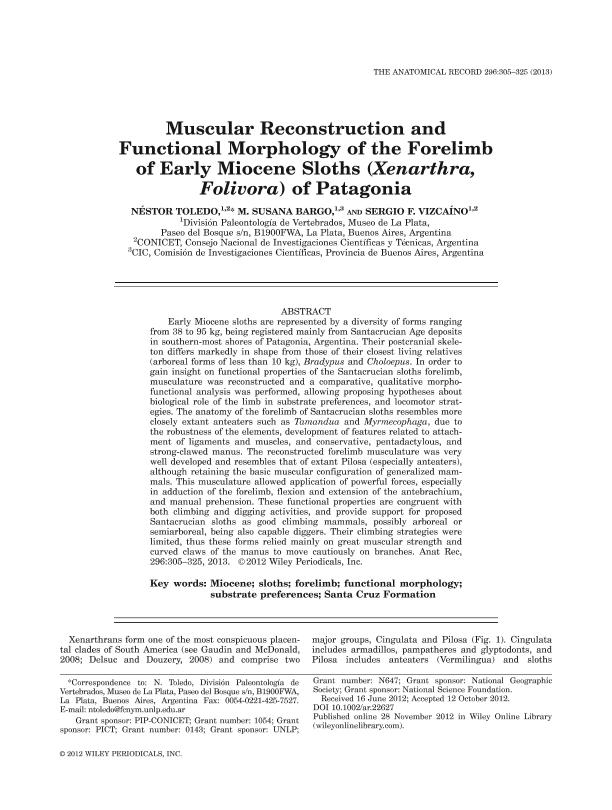Artículo
Muscular reconstruction and functional morphology of the forelimb of Early Miocene sloths (Xenarthra, Folivora) of Patagonia
Fecha de publicación:
02/2013
Editorial:
Wiley
Revista:
The Anatomical Record
e-ISSN:
1932-8494
Idioma:
Inglés
Tipo de recurso:
Artículo publicado
Clasificación temática:
Resumen
Early Miocene sloths are represented by a diversity of forms ranging from 38 to 95 kg, being registered mainly from Santacrucian Age deposits in southern-most shores of Patagonia, Argentina. Their postcranial skeleton differs markedly in shape from those of their closest living relatives (arboreal forms of less than 10 kg), Bradypus and Choloepus. In order to gain insight on functional properties of the Santacrucian sloths forelimb, musculature was reconstructed and a comparative, qualitative morphofunctional analysis was performed, allowing proposing hypotheses about biological role of the limb in substrate preferences, and locomotor strategies. The anatomy of the forelimb of Santacrucian sloths resembles more closely extant anteaters such as Tamandua and Myrmecophaga, due to the robustness of the elements, development of features related to attachment of ligaments and muscles, and conservative, pentadactylous, and strong-clawed manus. The reconstructed forelimb musculature was very well developed and resembles that of extant Pilosa (especially anteaters), although retaining the basic muscular configuration of generalized mammals. This musculature allowed application of powerful forces, especially in adduction of the forelimb, flexion and extension of the antebrachium, and manual prehension. These functional properties are congruent with both climbing and digging activities, and provide support for proposed Santacrucian sloths as good climbing mammals, possibly arboreal or semiarboreal, being also capable diggers. Their climbing strategies were limited, thus these forms relied mainly on great muscular strength and curved claws of the manus to move cautiously on branches.
Archivos asociados
Licencia
Identificadores
Colecciones
Articulos(CCT - LA PLATA)
Articulos de CTRO.CIENTIFICO TECNOL.CONICET - LA PLATA
Articulos de CTRO.CIENTIFICO TECNOL.CONICET - LA PLATA
Citación
Toledo, Néstor; Bargo, María Susana; Vizcaíno, Sergio Fabián; Muscular reconstruction and functional morphology of the forelimb of Early Miocene sloths (Xenarthra, Folivora) of Patagonia; Wiley; The Anatomical Record; 296; 2; 2-2013; 305-325
Compartir
Altmétricas




